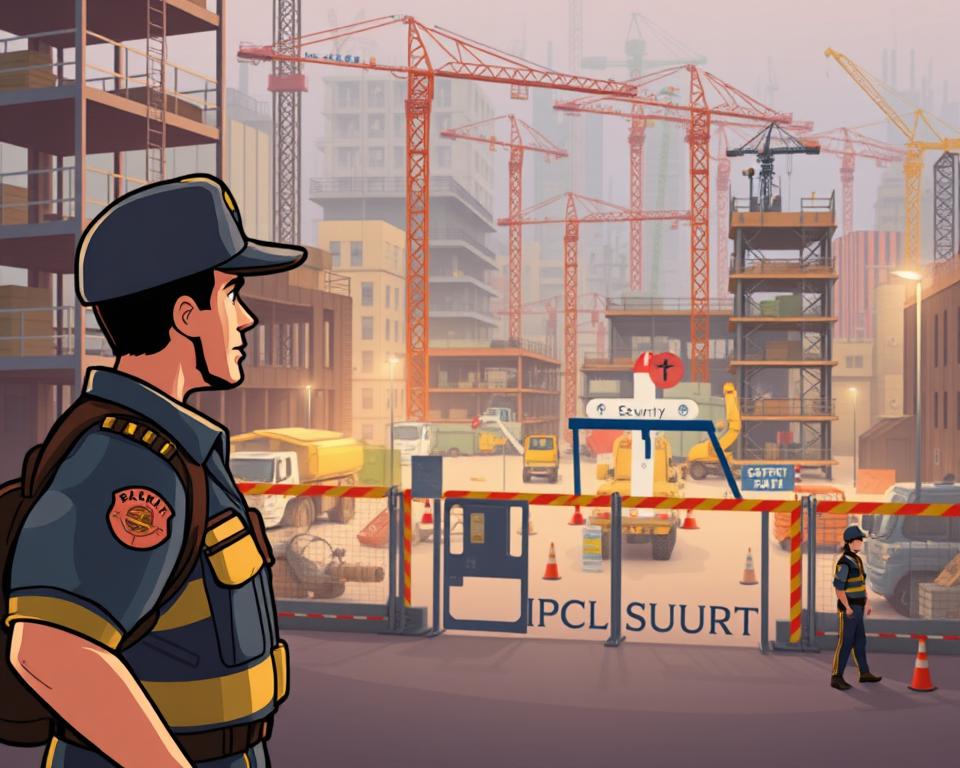Boost Your Project’s Job Site Safety Now
Imagine stepping onto your worksite the next day and seeing valuable tools stolen or perhaps equipment vandalized. How soon might obstacles like these derail deadlines along with financial plans? Job sites frequently house high-value items in unprotected spaces, thus leaving them easy targets. Lacking sufficient security measures, you’re not just risking materials—you risk all that your team has built.
Intruders regularly prey on areas with minimal oversight, mainly during off-hours. Mobile machinery theft alone costs companies millions each year. Holdups from replacing stolen items or restoring damage create stress plus surprise bills. Fortunately: preemptive 24/7 security guards security planning can turn vulnerabilities into strengths.
Divine Protection Services focuses on tailored security solutions in ever-changing sites. Their approaches integrate cutting-edge technology with field experience to help keep your assets secure. In the sections that follow, you can learn practical steps to prevent theft, control access, as well as maintain progress without sacrificing security.
Prepared to transform how you safeguard your workspace? Let us examine practical solutions designed to balance efficiency with ironclad protection.
Understanding the Basics of Construction Site Security
Each year, vulnerable construction sites experience millions of dollars in losses due to preventable incidents. Exposed spaces housing high-value gear draw opportunistic thieves, especially after dark. Let’s break down the primary issues plus why prompt measures are essential.

Identifying Weak Spots
Unlocked storage containers, unattended supplies, as well as insufficiently illuminated spaces become easy prey. Industry data indicates a 40% surge in theft during summer when construction ramps up. Typical weak points include:
- Overnight portable generators
- Copper wiring stored in visible areas
- Lacking perimeter barriers
Financial Impact Beyond Theft
One missing excavator could push project timelines back weeks while insurance claims process. Fixing vandalism frequently costs over $5,000 per case, rapidly draining budgets. Teams then face overtime pay to catch up—hitting productivity twice.
Simple fixes like motion-activated lights reduce after-hours breaches by 60%, according to safety studies. Pairing visible cameras with locked gates signals to intruders that risks outweigh rewards.
Putting these fundamentals in place initially, you set up a robust groundwork for next-level measures. In the following section, we’ll adapt solutions to your site’s distinct requirements.
Assessing Your Construction Site’s Unique Security Needs
Why certain sites are more at risk than others? Every worksite has distinct features that shape its risks. A thorough evaluation of your property’s layout, workflow, and assets is the first step toward building defenses that actually work.
Identifying Site-Specific Vulnerabilities
get a layout of high-traffic zones and material storage points. Do costly tools sit in dark corners? Is fencing incomplete near public roads? One safety guide notes: “Blind spots in busy areas account for 35% of after-hours thefts.”. Addressing these gaps early prevents headaches later.
Think about how storing supplies influences risk. Example: Copper wiring stored beside temporary entrances draws unwanted attention. Similarly, portable equipment left in open fields becomes an easy target. Site-specific tactics could include:
- Configuring lights to operate during active hours
- Setting aside lockable areas for valuable equipment
- Updating access routes to limit exposure
A tailored security blueprint safeguards both equipment and labor. Active precautions minimize downtime and protect finances. By focusing on your location’s unique needs, you create a shield that adapts as the job evolves.
Implementing Effective Security Measures
Good perimeter lighting does more than show the way—it repels intruders. Let us examine real-world enhancements combining tech and intelligent planning to secure your assets.
Lighting That Works Smarter
Lights triggered by motion wipe out hiding spots for unauthorized visitors. One site manager cut after-hours break-ins by 75% by placing these around storage zones. Add:
- Solar-powered lights for distant areas
- Timed settings matching work hours
- Weatherproof options for longevity
Barriers That Do More
Strong fencing not only outlines limits but also delays forays. A case study showed chain-link barriers with anti-climb features cut trespassing attempts by 60%. Pick barrier types that:
- Stand up to vehicular impacts
- Enable oversight by patrols
- Feature lockable entrances
Prominent signage operates as a wordless guard. “No Trespassing” warnings paired with alarm system decals make intruders think twice. A crew experienced no thefts after placing bilingual signs at entrances.
Current alarm solutions send live notifications to smartphones. Combine them with motion sensors and smart locks for layered protection. Schedule weekly checks with your crew to ensure all devices function properly—this small investment of time prevents big headaches later.
By implementing these measures now, you create a safer environment for workers and equipment. Regular updates keep your strategy effective as projects evolve.
Harnessing Technology for Site Protection
Gone are the days of relying solely on padlocks and patrols. Modern solutions combine cutting-edge tech with real-world use, building a net that protects 24/7. Let’s explore how smart tech solutions keep your assets protected without complicating workflows.
Eyes That Never Sleep
Modern cameras do more than record—they analyze. Pairing 4K video with motion sensors lets them spot unusual activity, like someone lingering near storage containers after hours. A contractor saw an 82% drop in theft by employing setups that ping alerts to smartphones. Options include:
- Solar-powered units for remote zones
- Weatherproof designs that withstand harsh conditions
- Night-vision infrared features for clear after-dark viewing
Constant recording documents all, and motion-triggered recording preserves battery. According to a tech report, merging the two approaches halves false alarms.
Advanced Entry, Enhanced Control
Access badges simplify tracking without slowing down crews. Scan-to-enter systems log who’s on-site and when—ideal for managing subcontractors. Advantages comprise:
- Live logs for auditing
- Remote credential adjustments
- Linking to alarm networks
A PM noted, “We identified a delivery mistake quickly since our logs recorded who entered the equipment shed.” Guards still play a key role, but tech handles the routine checks, freeing them to focus on high-risk areas.
These solutions augment human oversight rather than replace it. By merging tradition with innovation, you build a defense that’s as dynamic as your worksite.
Enhancing Protection Through Divine Protection Services
When was the last time your project’s safety plan adapted to emerging threats? Divine Protection Services stands out by treating every location as unique. They begin by conducting thorough evaluations, charting risks from storage layouts to nearby crime trends. This isn’t cookie-cutter protection—it’s precision.
Benefits of a Consultative Security Approach
Rather than off-the-shelf tactics, they examine your operations and site context. For instance, a highway project needed patrol adjustments according to local pedestrian patterns. Outcome: Six straight months without a theft. Their approach consists of:
- Field assessments by safety engineers
- Custom tech blends (drones + ground sensors)
- Monthly tactic adjustments to match project shifts
Skilled Security Staff and Guard Approaches
Guards here aren’t just watchmen—they’re trained in conflict resolution and tech systems. One team prevented $12k in losses by spotting suspicious activity near fuel storage. Their layered approach combines:
- Around-the-clock patrols on varied routines
- Immediate data updates on mobile units
- Quick-action emergency exercises
“We’ve reduced vandalism by 91% on partnered sites,” shares a company lead. By merging human insight with AI analytics, they create a shield that thinks ahead.
Steps to Block Unauthorized Entry and Theft
What if thieves could stroll right into your workspace unnoticed. Uncontrolled entry points turn projects into playgrounds for opportunists. One unguarded gate or ill-timed delivery can lead to issues—but thoughtful planning prevents intrusions.
Why Timing and Tracking Are Crucial
Schedule material drop-offs during active hours when teams can supervise. Research indicates 68% of thefts happen when items are left unsupervised overnight. Coordinating deliveries with crew availability makes sure items get logged and locked away right away
Restricting storage areas with secure access points lessens theft risk. Set aside locked lockers for valuable equipment with tamper-proof casings. As one project manager noted: “When everything has a designated spot, missing items stand out fast.”
- Close all but main gates during off-hours
- Implement RFID tagging for live equipment monitoring
- Conduct random audits during shifts
Skilled guards make a difference. Guards patrolling boundaries and verifying IDs keep trespassers at bay. Integrate guards with digital logging of visitor entry and exit times.
Small changes—like adjusting delivery windows or relocating storage trailers—create big barriers against theft. Review protocols weekly to close gaps before they become liabilities. Marrying logistics and protection ensures projects remain on schedule and within budget.
Ensuring Site Safety Through Comprehensive Risk Mitigation
What’s your backup plan if a storm floods your storage yard at midnight? Though cameras and fences serve as initial defenses, genuine safety derives from preparing for surprises. Combining insurance coverage with emergency protocols creates a safety net that keeps projects moving forward—even during crises.
Insurance Combined with Real-World Planning
Adequate coverage turns disasters into manageable setbacks. One project manager dodged $78k in losses post-theft—insurance funded replacements, keeping schedules intact. However, insurance by itself falls short. Match it with:
- Documented equipment inventories
- Round-the-clock response teams for security incidents
- Weather-responsive evacuation procedures
Test your plans quarterly. A Midwestern team averted injuries in a tornado by practicing shelter drills. Their drills cut evacuation time by 63% compared to neighboring job sites.
Today’s alarm systems incorporate emergency notifications. If sensors sense flooding or fire, they send automatic alerts to first responders. Such dual capabilities aid in preventing unauthorized access amidst crises.
Revise risk evaluations as the job progresses. New phases might require additional coverage or revised escape routes. As one safety director notes: “Treat your emergency plan like a living document—it grows smarter with every challenge.”
Merging financial protections and rehearsed actions secures both belongings and crews. Start small: review policies this week and schedule your first drill. Readiness now averts chaos later.
Addressing Common Security Challenges on Construction Projects
Securing a job site isn’t merely about installing cameras and fences—it involves daily collaboration and clever solutions. Staff changes, shifting schedules, and evolving layouts can strain even the best plans. A contractor confided: “We rotated through three security teams in a month—keeping consistent seemed unattainable.”
Managing Security Personnel and Daily Protocols
Frequent turnover complicates training and messaging. Streamlined checklists help new hires quickly learn patrol routes and reporting steps. For example, daily site walks with photo documentation cut unresolved issues by 45% in a Texas high-rise project.
Equipment tracking systems like RFID tags reduce losses. Use them alongside lockable storage zones for items such as power tools. Visible signage designating restricted zones further deters casual intruders. A Florida team saw thefts drop 30% after adding multilingual warnings near material piles.
Pressure to meet deadlines often compels quick decisions. One solution? Pre-scheduled access logs for deliveries and subcontractors. This manages urgent timelines while keeping entry secure. Weekly audits of storage trailers and fuel tanks add another layer of oversight without slowing work.
Job sites evolve rapidly—what was storage yesterday could be a concrete pour area tomorrow. Routine crew huddles guarantee everyone is aware of protocol changes. A manager observed: “Discussing security updates in safety meetings makes compliance pick up organically.” Minor tweaks keep security flexible as the project progresses.
Maintaining Long-Term Security with Best Practices
Steadiness is what turns quick fixes into lasting protection. View your security plan as a daily routine—tiny, deliberate steps lead to rock-solid outcomes. Routine reviews and evolving strategies uphold security during every stage of the project.
Establishing Accountability with Regularity
Routine daily inspections enable teams to identify problems before they worsen. A brief perimeter check can uncover a broken fence segment or a misaligned alarm sensor. A contractor caught an open storage container during a morning inspection, averting $8k in losses.
Thorough reports build records that boost accountability. Note weather impacts, equipment status, and any unusual activity. “Electronic logs revealed a pattern of off-hour deliveries that clashed with schedules,” said an Arizona safety manager.
Blend tangible measures with smart tech for total coverage:
- Reinforce fencing with tamper-lock connectors
- Test alarm systems weekly
- Employ geofence applications to watch off-limits areas
Conduct monthly strategy evaluations so your plan grows with the project. When a Florida team expanded their workspace, they adjusted patrol routes to cover new access points—reducing blind spots by 70%. Kick off immediately: pair up for walkthroughs, make concise checklists, and mark successes. One expert noted: “Security is a marathon, not a sprint—each step matters.”
Synthesizing Strategies for a Secure Job Site
Your project’s success hinges on more than blueprints and hard hats—it demands layers of protection that adapt to evolving risks. Combining physical barriers like sturdy fencing with smart alarm systems creates a shield that deters trespassers day and night. Regular patrols by trained security guards add human oversight, while motion-activated lighting eliminates shadows where thieves lurk.
Stopping unauthorized entry begins with basics: secure pricey gear in lockable storage areas, rotate access codes weekly, and place obvious cameras by entrances. Studies show properties using these methods reduce theft and vandalism by 70% compared to unprotected areas.
Divine Protection Services excels at crafting tailored solutions for dynamic environments. They unite sophisticated devices like IR sensors with proactive methods—random patrols, multilingual warnings, and instant breach notifications. One customer prevented $50k in losses when their system detected odd behavior at the perimeter.
Prepared to fortify your protection? Kick off today by examining weak points and arranging a free consultation. By planning ahead and leveraging expert help, you’ll construct more than sites—you’ll gain tranquillity.
Common Inquiries
What risks most frequently threaten job site safety?
Illicit entry, tool or material theft, and vandalism rank highest among risks. Exposed site designs, costly machinery, and distant locations frequently draw intruders. Bad weather and insufficient illumination can exacerbate vulnerabilities.
How do I block theft during off-hours?
Employ motion-activated lighting, strong perimeter fences, and obvious surveillance warnings. Secure high-value items in locked storage containers. Partner with firms like Divine Protection Services for after-hours patrols and real-time alarm monitoring.
What measures are ideal for short-term projects?
Portable anti-climb fencing, solar-powered cameras linked to cloud storage, and short-term access credentials for staff. Strategically placed motion sensors and daily equipment audits help maintain oversight in changing environments.
Is tech capable of replacing human guards?
Even though drones and advanced cameras improve oversight, skilled guards remain vital. Mixed approaches blending AI-driven analysis and on-site guards, such as verified security services, provide layered safety.
How to manage site access without hampering work?
Use RFID cards or biometric readers for quick checks. Define entry paths with visible signs and allocate distinct delivery zones. Align material drop-offs with crew presence to prevent unguarded stock.
Will insurance cover stolen equipment?
Major insurance plans demand evidence of adequate measures like alarms or manned checkpoints. Document all security measures, maintain equipment inventories with serial numbers, and file police reports immediately after incidents.
How frequently must security protocols change?
Review measures weekly as projects evolve. Upcoming project phases could call for altered camera placements, extra fencing, or revised access rosters. Conduct surprise audits to ensure teams follow protocols consistently.
What daily practices improve long-term safety?
Morning briefings to address risks, sunset equipment lock-down routines, and end-of-day perimeter checks. Deploy platforms like SafeSite for live incident tracking and digital recordkeeping of site operations.
Is deploying visible cameras adequate for deterrence?
Though they help, use them alongside other defensive measures. Post “24/7 Surveillance” signs, use gravel paths to detect footsteps, and vary guard patrol times. For vulnerable spots, fit conspicuous camera enclosures with blinking indicators plus concealed secondary cameras.

